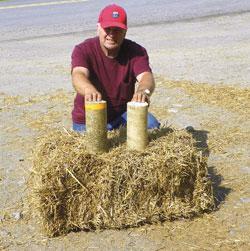 Instead of trying to sell rained-on hay for compost or watching it rot away, Peter Bragdon figured out how to compress hay into 5-lb. logs that will burn 2 to 3 hrs. With all the rain Maine typically receives, the horse hay farmer has rained-on hay every season. By turning it into hay logs, he hopes to get as much money for the waste hay as he does for horse hay.
Instead of trying to sell rained-on hay for compost or watching it rot away, Peter Bragdon figured out how to compress hay into 5-lb. logs that will burn 2 to 3 hrs. With all the rain Maine typically receives, the horse hay farmer has rained-on hay every season. By turning it into hay logs, he hopes to get as much money for the waste hay as he does for horse hay.
Hay tightly wrapped around the drive shaft of a baler gave him the idea. About $30,000 in development grants gave him the funds to build a homemade press and do research grinding and mixing the hay with different binders to get the right mix. Without a binder, hay at 10 percent moisture burns hotter than stove manufacturers recommend. The University of Maine tested the logs, which produce between 7,283 and 13,660 btus/lb., within wood stove manufacturers’ warranty.
“The logs are 5 lbs. each so I can get about 8 from a typical square bale,” Bragdon says. “If this works, I’ll switch to big round bales.”
Reports have been positive from consumers in the area who’ve tested the hay logs. They liked the aroma of the timothy and mixed-grasses hay. Because it doesn’t have the chemicals found in wood, there shouldn’t be any creosote, and only a fluffy ash is left to dispose of.
Bragdon found a wood compression manufacturer to modify equipment to compress the hay logs and is looking into a manufacturing grant or business loan to hopefully get set up to produce hay logs this year.
“I don’t care how long it’s in the field and when they mow it, but it has to be dry,” he adds.
1-800-834-9665
Hay Logs Add Value To Waste Hay
FARM SHOW Magazine » Hay Logs Add Value To Waste Hay
Hay Logs Add Value To Waste Hay
